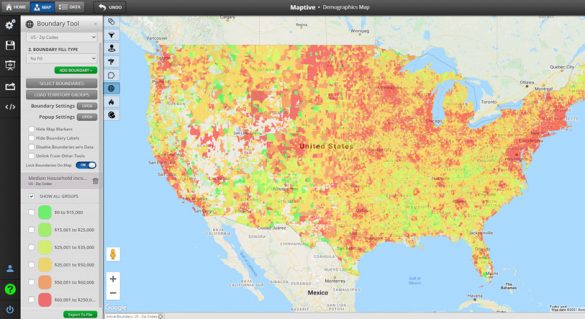
To grow your business, you need to find new customers. Of course, you could continue to fight over the same consumers that your competitors are targeting. However, a better strategy is to identify underserved niche markets and develop strategies to target them.
Underserved markets are groups of people that you and your competitors have overlooked. If you can find a way to address their needs, they represent a huge revenue opportunity for your business. It also means you can avoid lots of competition and gain a serious first-mover advantage.
Even if you have a thriving business, it’s always a good idea to look for ways to grow. So, how do you identify underserved groups?
By segmenting demographic data and plotting it on an interactive map, you’ll quickly see if there’s a void in your marketing that you can take advantage of. And when you combine this with sales territory mapping, you’ll be in a great position to execute your business strategy.
Table of Contents
Demographics refer to statistical data that’s used to measure different areas of society. For example, in business, demographics create different segments of consumers for you to analyze. This lets you quickly identify who’s doing business with you and who isn’t.
Demographics are used to measure a wide range of metrics, including:
Through data mining, you can determine which of the above categories apply to your customers. From there, you’ll be able to develop personas for your initial customers. You can then look at what type of people generally aren’t your customer and assess whether there are any opportunities to serve them.
As we just learned, there are many different types of demographic metrics. However, here are some of the most effective ones for sales:
Is your audience primarily male or female, or is it an equal mix of both? If your customers skew heavily towards one gender, you may want to look at how your products could benefit the other as well. Or you could develop a new line of offerings that better address the other gender’s needs.
While some products and services appeal to all ages, your audience will fall into a certain age range in most cases. By learning the average age of your customers, you can start thinking of ways you can change your brand image to attract other age groups.
If you notice that your customers come from only a few ethnicities, it could indicate that your marketing lacks diversity. Even though you have great products, there might be a lack of awareness among certain people. By creating ads that appeal to all races, you can potentially find a new stream of revenue.
Are your customers mostly lower-income individuals? Then you might want to develop a more innovative product that appeals to high-net-worth individuals. And if your audience is primarily high earners, consider developing new offerings that allow you to attract others segments of the population.
Still not convinced niche demographics can help your business? Here are five benefits you’ll enjoy when you use demographic segmentation:
Sales territory mapping is the process of dividing your service area into different territories. For example, as your business grows across America or internationally, it might become necessary to establish different sales territories. This makes it easier to ensure each area has the resources necessary to service your customers effectively.
Sales territories are often divided based on established geographic boundaries. This could be by neighborhood, zip code, county, or state. However, some companies draw custom territories based on the distribution of their customers.
There are many advantages of sales territories, such as better customer service, reduced travel for salespeople, and creating a level playing field for your sales reps.
When combined with demographic segmentation, sales territory mapping is a powerful tool for uncovering underserved markets. Plus, because you have local teams on the ground in every area, they’re better equipped to take advantage of new opportunities.
Overlaying segmented demographic data on your sales territory maps helps your team identify who their customers are, where their customers are, and the location of new potential customers. This ensures their marketing is more focused and streamlines productivity.
Best of all, by creating sales territories and assigning teams to each region, you don’t miss any opportunities. For example, you may spot an underserved market in a specific area. But if you haven’t developed effective sales territories, your team might be spread too thin.
However, sales territories ensure your resources are distributed effectively. This means if you find an underserved market, you have the people in place to jump on the opportunity. And because they have access to local market information, they’ll likely know how to appeal to that population segment.
Maptive makes it easy to segment demographic data and plot it using a heat map. It also includes sales territory mapping software so you can distribute your resources more efficiently. Sign up for a free trial and start mapping today.
Fred Metterhausen is a Chicago based computer programmer, and product owner of the current version of Maptive. He has over 15 years of experience developing mapping applications as a freelance developer, including 12 with Maptive. He has seen how thousands of companies have used mapping to optimize various aspects of their workflow.
